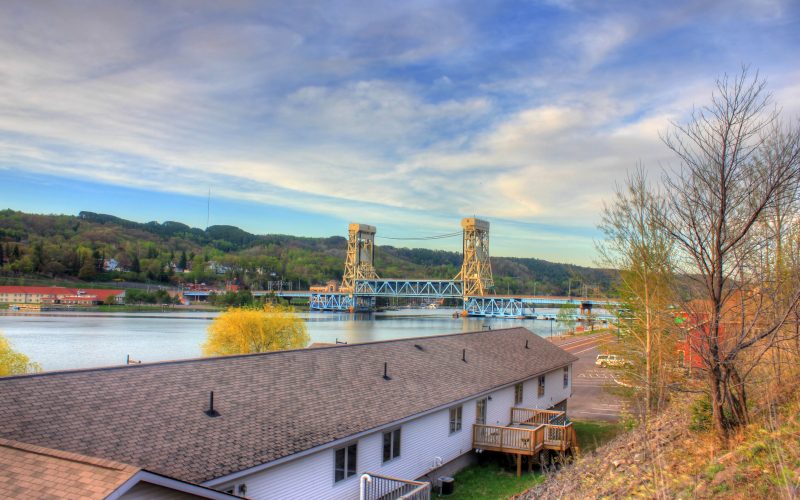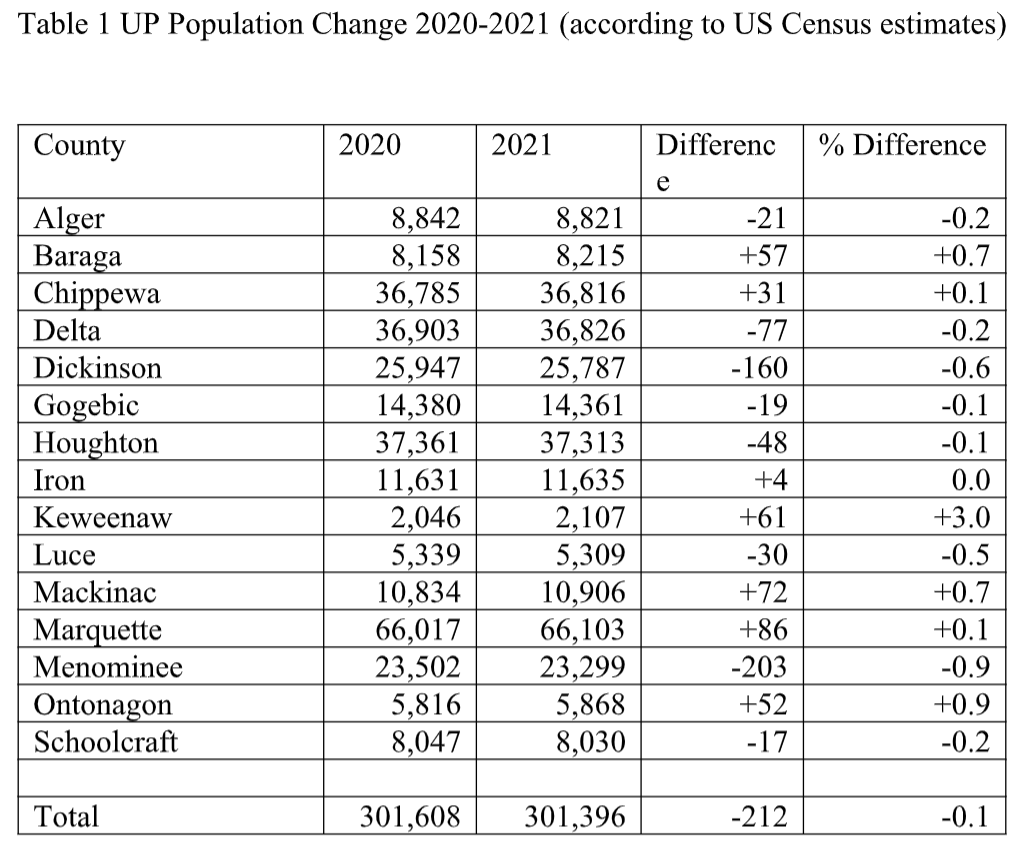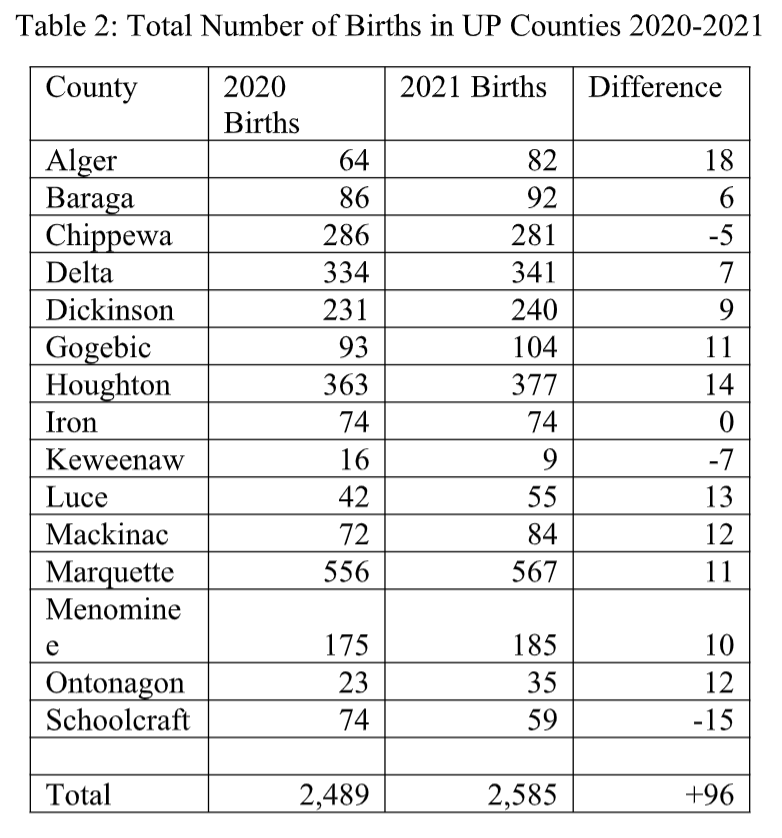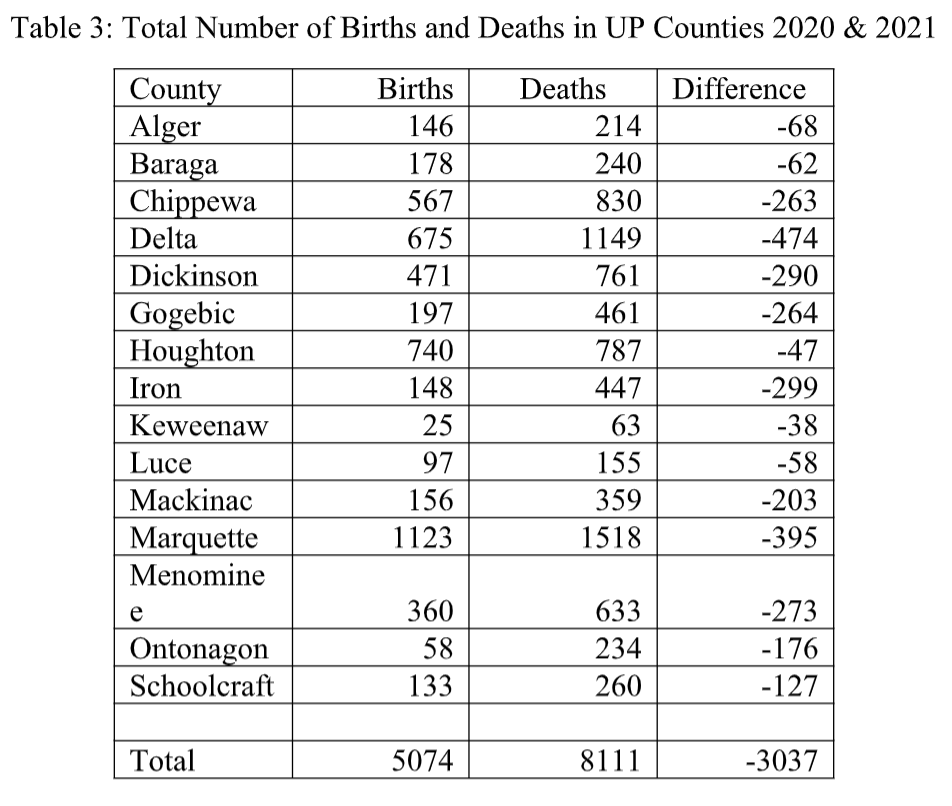Covid 19 and Population Change in the Upper Peninsula 2020-2021

Over the past two years, Rural Insights has published a number of articles analyzing recent population change in the Upper Peninsula using US census data.
The most recent census revealed, for example, that between 2010-2020 only Houghton County gained population; the remaining fourteen counties all lost population, continuing the region’s long-term population decline. This decline is attributable to a falling birth rate, rising mortality due to an aging population, and the failure of in-migration to offset the difference between births and deaths. The net effect is a drop in population.
Since 2020, two potential new factors have entered the equation: Covid 19, and the introduction of remote work. How have these affected U.P. population trends? Data from the Centers for Disease Control (CDC) show that of the more than one million Americans who died of Covid, 75% of them were over the age of 65.
Given the UP’s high proportion of elderly citizens, has this led to a further drop in population? And have people moved to the UP now that remote work options exist?
This article uses recently-available data from the Michigan Department of Health and Human Services on births and deaths, and the US Census Bureau’s latest population estimates to provide an update on the region’s most recent population changes in the midst of the Covid 19 pandemic.
2021 Population Estimates
The Census Bureau estimated that between 2020 and 2021 Michigan’s population declined by about 26,500, with the biggest losses associated with Detroit metro area counties. This 0.3 percent decline compares with an estimated population loss of 0.1 percent for the UP.
One of the reasons for the smaller population losses in the UP is that seven counties are estimated to have gained population (Table 1). Although the numbers are relatively small, they represent a significant departure from the previous decade’s population losses. Keweenaw, arguably the most isolated of UP counties, had the state’s largest population gain at 3% or 61 persons; with a county population of just over 2,000 persons this represents an important gain.
Other notable population increases occurred in Ontonagon, Baraga and Mackinac counties. The highest population losses occurred in Dickinson and Menominee counties on the Wisconsin border.
2021 Births
One possible explanation for a rise in population is an increase in births. According to the National Center for Health Statistics, the US witnessed a 1% increase in its number of births in 2021, referred to as the ‘Covid baby bump.’ This ‘bump’ was the nation’s first increase in births since 2014.
Despite the popular perception that keeping couples homebound during lockdown would lead to a baby boom nine months later, surveys conducted during 2020 found that as many as a third of American women changed their reproductive plans because of the pandemic. The 1% increase in births thus represents in many instances delayed planned pregnancies as future uncertainty was reduced by the introduction of vaccines and emergency government financial assistance.
The Upper Peninsula’s ‘baby bump’ was higher than the national figure at 4% (Table 2). Despite this gain, it is important to recognize that the region’s 2021 total of 2,585 births was still the third lowest annual total since 2010 (2019 and 2020 had the lowest totals at 2,499 and 2,489 respectively).
Nevertheless, 11 counties experienced small increases in birth numbers, with Ontonagon and Alger having the largest percentage gains. Interestingly, Keweenaw County, which had the state’s highest percentage population gain between 2020 and 2021, experienced a drop in births. With fewer births, the most plausible explanation for its population growth is in-migration.
2021 Deaths
It is difficult to discern whether Covid resulted in increased deaths in 2021, for the obvious reason that people began dying from Covid in 2020. What is apparent is that in the three years prior to Covid, the average number of deaths in the UP amounted to 3,617; in 2020 it jumped to 4,061, a 12 percent increase. In 2021 the number of deaths was largely unchanged at 4,050, suggesting that without Covid the number of deaths would be significantly lower.
Population Growth and Migration
In 2020 and 2021, there were 3,000 more deaths than births in the UP (Table 3). This inevitably means population decline unless the region can offset this difference by migration. Migration consists of two forms: in and out. In-migrants are people who move to an area from outside, while out-migrants are people who move away from an area.
The difference between the two flows is net migration and it must be positive for it to the contribute to population growth. In Keweenaw County, the number of deaths exceeded the number of births, yet the Census estimates that the population grew, which can only be explained by an increase in net-migration. The same phenomenon is evident in Baraga, Ontonagon and Mackinac where deaths exceeded births yet their population is estimated to have grown.
Covid and the UP’s Population
On March 17, 2020 the state of Michigan reported its first Covid death; since then the total number of Covid deaths has risen to over 40,000. During Covid’s early days schools were shut, college campuses closed, large gatherings banned and remote work became commonplace. For the UP, Covid’s impact is seen in the increase in the number of deaths and the 2021 ‘baby bump.’ Since Covid, some UP counties experienced modest population gains which is probably attributable to an influx of people engaged in remote work.
Looking ahead, the number of fatalities tied to Covid will likely decline due to vaccines and better treatment regimes, yet the number of deaths will still exceed the number of births for the foreseeable future, which means that positive net migration is critical to the region’s demographic future.
The ability to work remotely is clearly an important factor for some recent UP in-migrants, however whether businesses and governments will continue to allow remote working remains uncertain and that casts a shadow over the region’s future population.









Thanks for the updated information. I would love to see an article exploring the discrepancy between population loss over the past decade (with a possible tiny reversal recently) and the growing housing problem. What we are seeing is lots and lots of second (and third and fourth?) homes; housing converted from long term to short term rental and… ??? Development of land and addition of housing continues unabated despite population being (relatively) stable. What are we going to do if population actually begins to increase significantly?
“Development of land and addition of housing continues unabated despite population being (relatively) stable.”
Affordable housing for the demographic that would increase population growth is nonexistent, while pricey options are available for that demographic that are older part-time residents.
Short term growth, at the expense of a long term plan that encourages a younger generation to stay HERE, is what the problem is and will remain due to short-sighted greed of the planners and developers.
Short-sightedness and short-term economic boosts have been the bain of the country, leading to all sorts if social problems.
There are several logical shortcomings and faulty assumptions with this statement: “Short term growth, at the expense of a long term plan that encourages a younger generation to stay HERE, is what the problem is and will remain due to short-sighted greed of the planners and developers.”
First, planners and developers don’t work together on plans. Private property owners develop land. Planners work out appropriate locations for various types of land uses.
Property developers are not making private property development decisions based on short-term trends. To make development profitable typically requires many years/decades of revenue from a large investment that is completed as planned and under or not above budgeted costs. Homeowners, on the other hand, can make substantial profits in a short time from a home sale – and that drives up the cost of other housing. If you want someone to blame for the cost of housing you are barking up the wrong tree dog. It’s not just flipping/selling houses for a big payout that has driven cost up, not even close. The facts are that housing construction halted in most places around 2008 after the mortgage-default swap scandal led to the Great Recession, wages were suppressed for years, building material costs have increased a lot, and skilled labor to build homes has become more scarce and thus more expensive.
Planners are trying multiple avenues to make development less costly, time-consuming, and easier (while increasing environmental protections) these days, with the housing crisis in mind. The City of Marquette has been working in this manner for several years, particularly through zoning changes that included creating hundreds of parcels of property where duplexes, triplexes and larger multi-family dwelling units can be built.
Also, there are many agencies in the UP and each county or region working on job creation and retention: the LSCP, Innovate Marquette/Smart Zone, and Northern Initiatives, for starters. And the three UP regional Planning agencies, County agencies, and municipalities are doing everything in their power and budgets to create infrastructure and other frameworks to make our communities good, attractive places to live (which is a huge factor in whether people want to stay or move to a place despite the job outlook). So, yeah…its complicated and it is unfortunate that housing has become extremely expensive, but that won’t last forever.
Thanks for the analysis! I have tracked nearly 170 individuals working remotely in Keweenaw, Houghton, and Baraga counties since starting the Remote Workforce Keweenaw initiative in 2018. This region has been having success drawing individuals who embrace winter and value the lifestyle, lack of congestion, and lower crime found here. A very large percentage have come from metropolitan areas in the Midwest, but we are having success with other regions with climate being a factor as well. You can learn more about Remote Workforce Keweenaw by visiting https://remoteworkforcekeweenaw.com and learn about those making the decision to locate here by following the Remote Workforce Keweenaw Facebook page at https://www.facebook.com/RemoteWorkforceKeweenaw. You can also find Remote Workforce Keweenaw on YouTube, Substack, and Pinterest.
The UP has long been stripped of its best economic resources, as defined by highly profitable, non-renewable extraction, especially mining and timber. The boom and bust consequences of mining and timber damaged the UP for decades. Fishing helped to produce income and support the UP but that turned out to be non-renewable as pollution and invasive species killed off fish stocks.
The only obvious renewable resource appears to be tourism, defined as whatever draws a seasonal influx of visitors who spend money and then leave until the next season. In a way, the UP is a large park emphasizing recreation and outdoor sports in the minds of tourists. Right now the lack of reliable and sufficient employees poses a limit to meeting the demands at the present level of tourism. This labor cap is not all bad in terms of protecting the natural beauty and attraction of the UP from being overrun, as it is now in several areas. And, yes, the conversion of family housing into short term rentals is devastating to places like Grand Marais.
Birth rates should be examined as to how many are based on married, family-forming births versus teen and out of wedlock births. The former present the possibility of stability while the latter present instability and potential dependence.
Noted in a previous comment, the departure of younger women is the most concerning piece of data which you seem to want to avoid mentioning. Finlandia University has closed for several reasons with the decline in young females being a part of the cause. There is a good argument to be made that the UP is facing a demographic cliff that no one wants to put front and center.
To your credit, you, at least, keep pointing to this threat. So far there are few good solutions to increasing the number of young families who choose to stay or move to the UP because they are able to support themselves with work- based incomes that include basic benefits. No, remote work is not the salvation.
Thanks for sharing this. For those interested, you can also find this report on migration and population change in the UP historically and through the first years of the pandemic. https://www.mtu.edu/social-sciences/research/publications/reports/full-report-up-pandemic-migration.pdf
The Executive Summary version is here- https://www.mtu.edu/social-sciences/research/publications/reports/executive-summary-up-pandemic-migration.pdf
Richelle Winkler, and her colleagues at MTI, are the best sources of demographic analysis and insights into the conditions and prospects for the Upper Peninsula. Significant asset in understanding causes and framing solutions.
No bias or favoritism here, I only know Richelle Winkler from her reports and analysis.
I would like to comment on the timber in Michigan. Timber is a renewable resource. 100 years ago the timber was clear cut leaving barren areas. These areas are now covered with new timber. Current logging practices take into consideration good scientific timber management practices, providing for a continuing source of timber products.
When I go to the grocery store, I always request paper bags and not plastic, because the paper bags are made from a product that is renewable. Not so for the plastic bags.
We may see lots of trees in the UP but the quality and harvested quantity is paltry when measured against the clear cutting of tens of millions of board feet of white pine that fueled a boom that lasted barely 30 years. It was over by 1910 and has never been reproduced since then. That’s non-renewable.
The depleted soils of the UP left after the boom period of clear cutting are not favorable for substantial growth of white pine with straight grain suitable for construction. Commercial quantities of valuable hard woods barely exist now, also removed during the boom and a few decades after. What is renewable are trees suitable for some grades of paper, OSB and low value pulp products, like that in your grocery bag.
One notable demographic factor that deserves mention are the prisons located in the UP. They skew age and gender data for the counties they are located in.
Great topic
Thank you for discussing this very important topic. The Covid 19 pandemic was a challenging time for everyone.